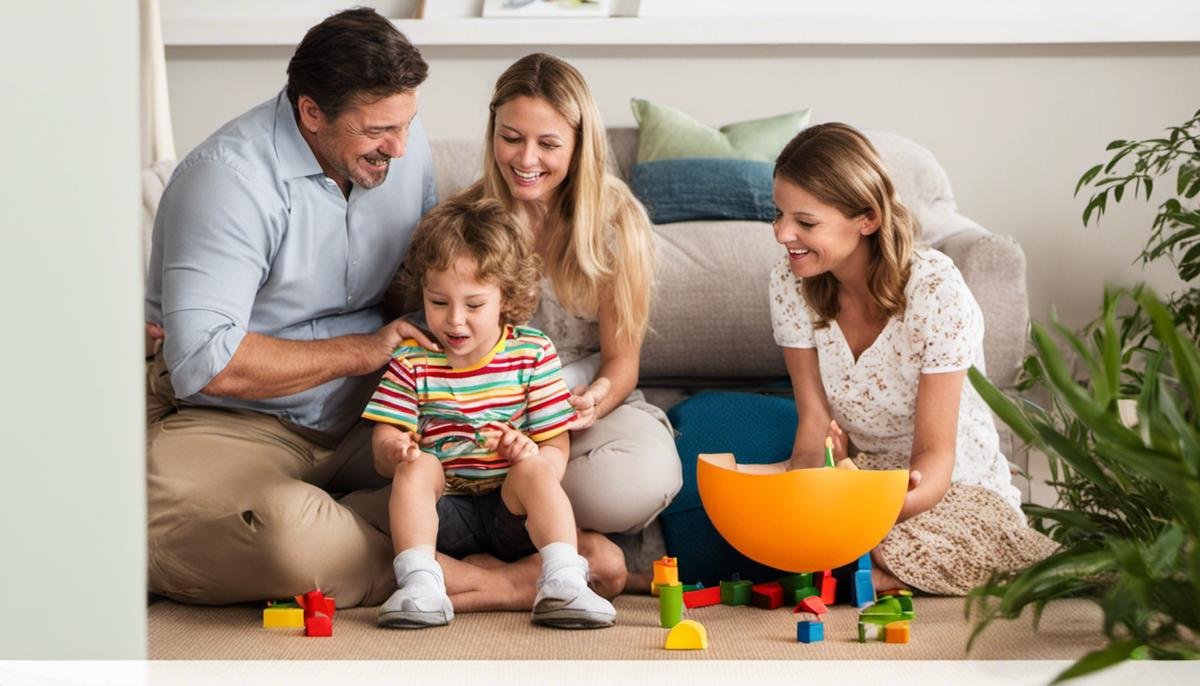
As we delve into the world of Applied Behavioral Analysis (ABA) therapy, it’s important to understand that this science doesn’t just magnify the nuances of human behavior, but serves as a beacon of hope for countless families across the globe. Originating from the principles of behaviorism, ABA therapy has emerged as a prominent therapeutic approach for a wide range of disorders and has garnered significant recognition for its effectiveness in children with Autism Spectrum Disorder (ASD). The purpose of this paper is to shed light on the importance and functioning of ABA therapy, along with sharing the inspiring success stories that demonstrate its potential. Further, we will explore the challenges associated with this therapy and how families have managed to navigate them, leading to a strengthened household that supports ABA therapy.
Understanding ABA Therapy
Demystifying ABA Therapy: A Helping Hand for Child Development
Every parent’s wish is to see their little ones grow and develop successfully, and an integral element of this journey is ensuring they receive the right support when it’s needed. One avenue that’s increasingly gaining acknowledgement in the field of child development is ABA Therapy, and rightfully so. But what is ABA therapy, and how does it contribute to children’s development?
ABA therapy, or Applied Behavior Analysis therapy, utilizes a scientific yet compassionate approach to understand behavior and its implications and encourage healthy behavioral changes in children. The therapy, widely recognized globally, works effectively for all children but is especially beneficial for children with developmental disabilities like Autism Spectrum Disorders (ASD).
The beauty of ABA therapy lies within its core, which is about training behavior. It relies on observing a child’s conduct in varying scenarios and pinpointing the environmental factors affecting them. This thorough understanding facilitates the development of personalized strategies that encourage positive behaviors and reduce harmful ones.
However, what makes ABA therapy stand out? How is it conducive to children’s development? There’s a reason this approach has gained significant traction!
Firstly, ABA therapy helps in developing critical life skills. From improving verbal communication and reading to honing social skills and adaptive learning abilities, ABA has got it covered. The therapy helps children better interact with their environment and positively participate in their communities.
ABA therapy also strives to build independence by teaching self-care skills. Through well-constructed and customized plans, ABA therapists focus on empowering children with the abilities to dress themselves, brush their teeth, or even prepare a simple meal. The invaluable self-care skills instilled throughout this process contribute significantly towards a child’s independence.
Furthermore, ABA therapy endorses a positive, nurturing environment for children. With ABA methodologies centered around reinforcing good behavior, children can expect an encouragement-rich environment that stimulates growth. This supportive environment not only helps children learn faster but also makes the learning enjoyable.
Last, but importantly, ABA therapy involves family. Parents and siblings join the therapeutic process, learning strategies to promote and support desired behaviors at home. This family-inclusive approach ensures that the learning and development aren’t confined to therapy sessions, making improvement a 24/7 process.
ABA therapy isn’t a one-size-fits-all approach, and that’s its strength. It recognizes that every child is truly unique, embracing diversity in growth and development. However, it’s crucial to point out that ABA therapy doesn’t replace parental love, guidance, and nurturing; it merely supplements them, aiding a child’s journey towards reaching their full potential.
So, mom and dad, embrace the journey – the ups, the downs, the milestones, and even the therapy if needed. After all, every step taken, every technique learned, and every moment shared in this journey only strengthens the love and bond within the family. And isn’t that what parenting is all about?

Success Stories of ABA Therapy
Parents often bear witness to several noteworthy transformations in their children as a result of Applied Behavior Analysis (ABA) Therapy. The specific changes may vary from child to child but the journey is usually paved with many rewarding moments, with children reaching milestones and demonstrating abilities that were once considered challenging or even impossible.
One of the first transformations that parents notice is the noticeable surge in their child’s communication skills. ABA Therapy, with its focus on shaping and guiding behavior patterns, helps children express their needs, wants, and thoughts more clearly and effectively. It is not uncommon for parents to relish the sound of their child’s voice echoing through the house, a sound that was previously an occasional echo.
Moreover, ABA Therapy fosters improved social interactions. It teems with opportunities for children to engage in interactive play, cooperate with others, and understand social cues. Many parents report their children developing new friendships and exhibiting increased participation in social situations.
Next, observers often find a marked improvement in their child’s adaptive learning abilities. ABA Therapy encourages children to adapt to new environments, challenges, and changes more readily. This adaptive ability is particularly heartening to see as it often translates into the child being more comfortable with new surroundings, whether it’s a different classroom, a new vacation spot, or simply a change in their daily routine.
Many parents notice improvements in their child’s self-care skills due to the therapeutic focus on promoting independence. Simple acts like tying shoelaces, brushing teeth, or dressing themselves, which are significant markers of independence for many children, often become easier and more efficient due to ABA Therapy. Witnessing their child complete these tasks with confidence is indeed a joyous moment for many parents.
Also significant is the improved family dynamics. ABA Therapy doesn’t just work on the child, but also involves the family, creating a wave of positive transformations within the household. Siblings learn to understand and assist their brother or sister, parents become more supportive coaches, and as a whole, families seem to become stronger, more understanding units.
Lastly, the magic of ABA Therapy is in its diversity and personalized approach. Parents find their children growing and developing in ways particular to them, embracing techniques resonating with their unique personality. This makes every achievement more rewarding and special, a testament to the individuality and resilience of their child.
Devoted parents, on their constant journey of nurturing their children, often disclose that the transformations brought about by ABA Therapy are nothing short of miraculous. It’s not just about modifying behavior; it’s about refining a child’s abilities, fostering growth, and helping them reach their full potential. Seeing their child bloom into their best selves brings unparalleled satisfaction and reinforces the parent’s unwavering commitment to their child’s growth and well-being. Ultimately, ABA Therapy proves to be a beautiful marinade of love, guidance, structure, and skill development that helps every child burgeon beautifully.

Navigating Challenges in ABA Therapy
Despite the widely recognized benefits of ABA Therapy, parents and caregivers may encounter various challenges during the implementation phase. These hurdles could range from difficulties engaging children in therapy, securing appropriate funding, misinformation about ABA Therapy, to resistance from the child themselves. But remember, every worthy journey comes with its fair share of bumps and bends. So, let’s delve into these challenges and strategies to navigate through them effectively.
Initiating ABA Therapy can be a daunting task, especially if the child exhibits resistance. Kids might find it challenging to understand the need for the therapy, and it’s not uncommon for them to display emotional discomfort in the process. Parents and caregivers should approach this with patience and reassurance. Using easy-to-understand language, explain the therapy’s importance and how it aims to help them master new skills and improve their quality of life. Familiarity with the process can help reduce anxiety and resistance substantially.
Funding for ABA Therapy can be another challenge for families. ABA Therapy, although effective, can also be costly. Many families find it stressful to navigate the multitude of funding options available. Collaborate with local support groups, non-profit organizations, or your healthcare provider to explore different avenues for financial assistance. You’d be surprised how much assistance is available – just ask!
Misinformation and myths surrounding ABA Therapy can also be an impediment. This could lead to unrealistic expectations or fears about the therapy’s outcomes. Do your homework by reading authentic sources or speaking directly with licensed ABA practitioners before passing judgment. Not everything you read on the internet is true – sometimes, the success stories are waiting just beyond the cloud of misconceptions.
Lastly, parents themselves might struggle with the requirement of active participation in their child’s ABA Therapy. The time commitment required for active involvement can seem overwhelming with juggling both work and home life. Open and honest communication with the ABA team can help achieve a balance, whether it be flexible scheduling or supportive resources that help parents contribute effectively.
Recognizing these roadblocks is a step towards developing a well-thought-out plan that complements the individual needs of the child and family. Remember, parents and caregivers are not alone in this journey. Reach out to supportive communities, professionals, and fellow parents – they can offer ideas, guidance, and reassurance. By learning and moving on, we can embrace the challenges of ABA Therapy and look forward to brighter horizons. Happy parenting!

Supporting ABA Therapy at Home
Bringing ABA Therapy Home: Tips for Success
Often called the world’s best classroom, home is where daily patterns of behavior, family connections, and lifelong learning habits take root. When ABA Therapy is integrated into this comforting space, it greatly escalates the levels of productive learning, consistent improvement, and desired behavioral changes in children with ASD. Here are some meaningful ways parents can bolster the positive effect of ABA Therapy right at home.
-
Consistent In-Home ABA Sessions
Involving your child in regular home-based sessions can reinforce the teachings of their formal ABA Therapy. Assisting them in this personalized, nurturing environment aids in better understanding, faster retention, and a comfortable application of acquired skills.
-
Incorporation of the Natural Environment
Familiar, everyday surroundings provide ample opportunities to apply the principles of ABA Therapy in real-life scenarios. Simple family activities – like mealtime, cleaning up toys, or even grocery shopping – can become valuable teaching moments.
-
Offer Positive Reinforcements
Giving your child positive reinforcement boosts their motivation to continue their learning journey. This could be anything from verbal praise to a treat, or extra playtime when they apply a learned skill or exhibit desired behavior.
-
Regular Learning Material Review
Even if the “therapy hour” has lapsed, don’t shy away from reinforcing learned material into your kid’s daily routine. Consistent encouragement and practice go a long way in establishing stronger connections and ensuring long-term progress.
-
Design Skill Building Activities
Incorporate enjoyable activities designed to practice useful skills. For instance, a simple game of catch can improve motor skills, or an interactive storytelling session can work on enhancing communication skills.
-
Set Realistic Goals
Remember, every child’s progress comes at its own pace. Understand your child’s unique capabilities to set achievable daily, weekly, or monthly goals. This will help in maintaining a positive sense of achievement and ongoing motivation.
-
Be Patient and Persevering
Success with ABA Therapy can be a gradual process. Children may take time to warm up to the therapy, and sometimes progress may seem slow. But remember, patience and persistence are your best allies in this journey.
-
Strong Collaboration with the ABA Team
Maintain an open line of communication with your child’s ABA team. Discuss their progress, appreciate the efforts, and share concerns if any. Successful ABA Therapy is undoubtedly a collaborative endeavor.
Lastly, one can’t undermine the value of a supportive and empathetic community in this journey. By connecting with other parents who are navigating the same path, sharing experiences and resources, exchanging tips and gaining strength from each other’s stories is profoundly rewarding. Whether you join an online group or meet in a local park, the sense of being understood on a deep level can be an invaluable source of encouragement.
Strengthening the impact of ABA Therapy at home is a dynamic process, one enriched with learning, reflecting, adjusting and growing. As you nurture your child’s development, keep in mind – with every small step forward, you are truly making a world of difference in your child’s life.

Real-world successes stand testament to the power of Applied Behavioral Analysis and its ability to enhance the quality of life for children dealing with Autism Spectrum Disorder. Overcoming the myriad challenges that ABA therapy brings along is no small journey, but as we have seen, it has been a journey worth taking for many families. Understanding and appropriately implementing ABA therapy at home is a vital part of this journey. It reins in the patience, persistence, and belief necessary to facilitate growth and development in these courageous children. In essence, ABA therapy doesn’t just foster behavioral improvements, it paves the way for a renewed outlook towards life and propels these incredible children towards their maximized potential.




